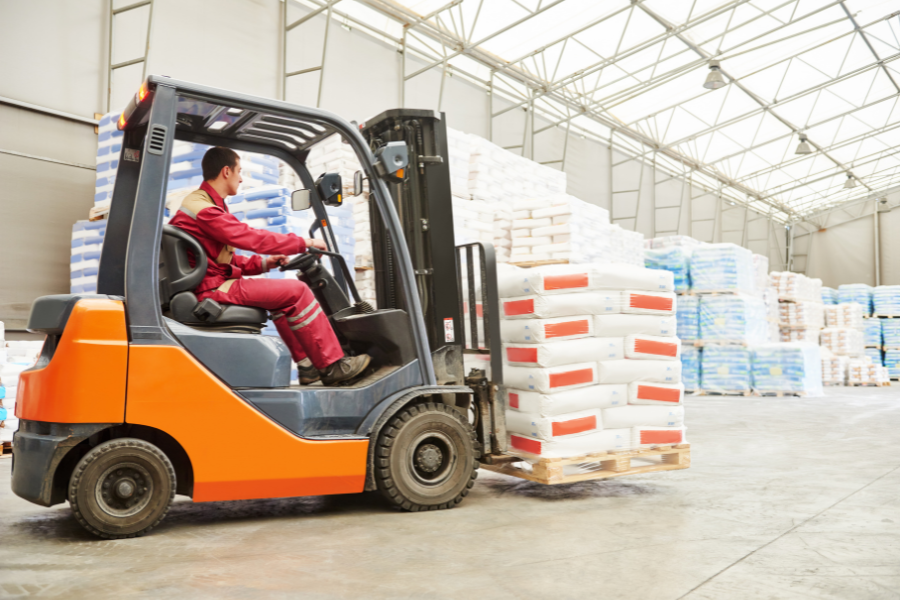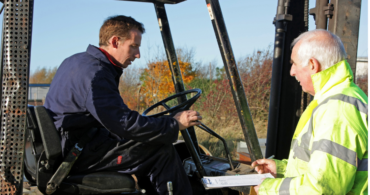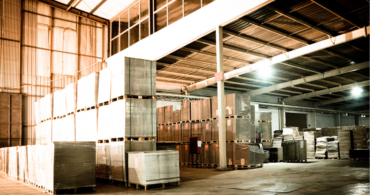A forklift is one of the most straightforward machines. It’s designed to do one thing exceptionally well: picking up pallets.
Our world is full of many great combinations: peanut butter and jelly, apples and cinnamon, chocolate syrup and ice cream. While we acknowledge that we may just be hungry, we would also include a non-edible entry to the list: the forklift and pallet. Place anything on a pallet and a forklift can easily move it from place to place (assuming it’s loaded properly and meets the machine’s weight requirements—safety first).
There is an excellent reason that the forklift wood pallet is such a perfect combination: they are created to work together.
A pallet-able solution: Understanding pallets
Pallets. They may seem like shafts of wood assembled in such a way to be best carried by a forklift, and they are. One of the definitions of pallet is “a portable platform for handling, storing or moving materials and packages. (Another definition is “a lever or surface in a timepiece that receives an impulse from the escapement wheel and imparts motion to a balance or pendulum,” which is fun to know…we guess.)
However, pallets weren’t always the primary means for “handling, storing or moving materials and packages.” That’s because, when we travel through the history of forklifts, the earliest machines lacked the main feature that makes them work so well with a pallet: the forks. Even once forks and pallets entered the scene, a lack of standardization meant that a truck might be unable to lift the palletized cargo.
Then, during World War II, the U.S. Department of Defense needed a more efficient method to transport military supplies. So, they assembled a team to study multiple options. (Have you seen the movie, “Oppenheimer?” It was probably just like that, only with pallets.) The panel concluded that forklifts and pallets were the most efficient system. This led to the invention of a standard, 1200 x 1000 millimeters, “four-way entry” pallet, which allowed forklifts to lift a pallet from any side (and resulted in our favorite forklift wood pallet combo).
However, standardized nationally does not mean standardized globally. In Europe, the standard size of a pallet is 1200 x 800 millimeters. This is known as a Euro-pallet (or EUR-pallet or EPAL-pallet), and it’s regulated by the European Pallet Association (EPAL). The America 1200 x 1000 millimeters standardized pallet is also used in Japan and is known as an ISO pallet or universal pallet (despite not being used universally). Additionally, some industries have unique needs that require pallets of other dimensions. These custom pallets can vary widely in size and shape.
In general, there are four material types used to construct pallets. They include:
- Wood—This is the most common material used to manufacture pallets. Wood pallets are affordable, easy to repair and widely used in various industries.
- Plastic—Plastic pallets are durable, sanitary and resistant to moisture and chemicals. They are often used in food and pharmaceutical industries.
- Metal—Metal pallets are exceptionally strong, making them suitable for heavy-duty applications. They are commonly used in manufacturing and automotive industries.
- Corrugated paper— Paper pallets (in addition to being a tongue-twister; go on, say it five times fast) are surprisingly strong and can handle most of the same cargo as a wooden pallet. They are also inexpensive, lightweight and environmentally friendly. Their downside is a limited lifespan (often a single use).
In addition to being constructed from different materials, there are also seven different styles of pallets, such as:
- Blockboard pallets—These are the standard four-way entry pallets forklift operators adore.
- Stringer pallets—These pallets provide extra support due to the solid boards that run along the left and right sides of the pallet. The tradeoff is that this is a two-way entry pallet. (Some Stringer pallets convert to four-way entry by cutting notches into the solid boards.)
- Double-face pallets—These pallets are reversible because they have a solid top and bottom.
- Double-wing pallets—The top slats extend beyond the frame to increase these pallets’ carrying capacity.
- Solid deck pallet—The top of the pallet is constructed with a solid piece of material to carry small items that may fall through the cracks of other pallets.
- Roto-molded pallets—Plastic pallets made using a rotational molding method, which makes them hollow. Some roto-molded pallets include a steel frame to increase their load-bearing capacity.
- Injection molded pallets—These are solid plastic, so they tend to be stronger than roto-molded pallets. They are also washable and recyclable.
How to lift a pallet with a forklift
1. Prepare the forklift
Before an operator approaches a loaded pallet, they must first ensure that their forklift is ready to tackle the day’s labors.
Begin with a visual inspection of the entire forklift to ensure no visible damage, leaks, signs of wear and tear or loose or missing parts. Check out the forklift’s tires to make sure they are inflated, the tread is good and there are no signs of damage. Next, top off any oil, hydraulic fluid or coolant as needed.
Once you climb into the machine, but before moving, inspect the brakes and controls, including the steering, horn, lights and backup warnings. Also, make sure the seatbelt works by fastening it around you.
If you are new to the machine or have concerns about a cargo’s weight and the forklift’s ability to handle it, review the forklift’s data plate to learn the maximum load capacity. The data plate is either on the instrument panel near the controls or the engine hood next to the seat.
2. Approach the pallet
Even when traveling with empty lift forks, it is essential to follow the same safety procedures as you would when carrying a loaded pallet: travel at a safe speed, follow the traffic rules, watch for pedestrians and keep the forks as close to the ground as possible.
Once you reach the palletized cargo, approach the pallet slowly and carefully. Evaluate the area around you by checking for obstacles and making sure you have enough space to maneuver. Next, position the forklift so that it’s aligned with the pallet. If a load is misaligned, it can be difficult to lift, and you may damage the pallet or cargo.
Next, lower the forks so they are close to the floor and can easily slide under the pallet. Leave a few inches between the forks and the pallet so you can make any adjustments. If the pallet is a different width than the forks, adjust as needed.
3. Lift the palletized cargo
Move the forklift forward slowly and smoothly. Insert the forks into the pallet’s openings. Before engaging the hydraulics, check that the forks are positioned correctly in the pallet.
The load must be evenly distributed on the forks to ensure that the palletized cargo is safe to transport. An unbalanced load can cause instability during lifting and transport. Also, no part of the load should extend beyond the forks. Any load overhang can negatively affect stability.
Once you know the cargo is safe and stable, engage the hydraulic system and lift the load slowly and smoothly. A gradual lift helps prevent unexpected movements that could cause the load to shift.
How should a lift operator travel with a full pallet on the forks?
Transporting a pallet safely is crucial to prevent accidents and protect the load, operator and other workers.
Ideally, a forklift operator has an unobstructed view while traveling. Granted, it may be a little difficult since they just picked up a large obstruction and placed it directly in front of their view. This is one reason to travel with the forks as low to the ground as possible (the other reason is that it helps maintain the vehicle’s stability). Also, an operator should adjust their seat and the mirrors as needed to improve visibility.
Always drive at a safe and consistent speed. Rapid acceleration and deceleration, sudden starts and stops or sharp turns can cause the load to shift or slip off the forks. Also, be aware of and use the horn at pedestrian crossings and obey the facility’s traffic signs and signals.
If you encounter any obstacles or uneven surfaces, here are a few techniques to help you navigate:
- Inclines—Decrease your speed and evaluate the incline’s steepness and condition. If possible, drive straight up or down the incline. Keep a firm grip on the steering wheel and avoid sharp turns and sudden movements.
- Uneven terrain—Visually inspect the surface for potential hazards, such as holes or debris. Keep a slow, steady pace to minimize shocks and proceed with caution. When stopping, apply the brakes gradually and evenly to avoid skidding.
- Obstacles—Always scan your path for obstacles. If you encounter one, stop the forklift to determine the safest way to proceed. If the obstacle walks on two legs, use your horn or another form of verbal communication to alert the obstacle of your presence so it gets out of the way.
Pull pack pallet forklift storage system
When it’s time to place the pallet into the warehouse racks, first, position the forks to the appropriate height of the storage location. Next, align the pallet to ensure it is centered within the warehouse racks. Some storage areas may have guide marks or indicators to help position the load accurately. Finally, lower the pallet gradually and smoothly.
One of the most common warehouse storage techniques is the “pull pack” system, where items are readily available for removal and shipping. Forklifts are crucial in efficiently managing inventory and expediting the “pull pack” system in several ways, including order picking, high-level storage and organizing and replenishing.
Forklift crates alternatives
When it comes to lifting and moving pallets around a warehouse, there are many forklift alternatives that can perform the job. However, depending on the machine, they may not be able to handle as much weight as the good ol’ trusty counterbalanced forklift.
Some forklift alternatives include:
- Reach trucks—These machines have front stabilizing legs that help offset the weight and very long tines that can extend deep into the racks.
- Pallet trucks—The operator walks behind the machine using a long handle and hand control to steer, load and unload the vehicle.
- Telehandler—Primarily used outdoors and at manufacturing facilities, telehandlers feature a telescoping arm that can extend as much as 30 feet (some models can go further) and up to a 70-degree angle.
Forklifts can also utilize specialized attachments to help them adapt beyond carrying pallets. Some common forklift attachments include:
- Extensions—To increase the forks’ length to handle long loads.
- Rotating clamps—For carrying drums or cylindrical loads, they can rotate to position loads horizontally or vertically.
- Bale clamps—To transport baled material like paper, cardboard, textiles and recycled resources.
- Telescopic forks—Used for stacking applications to reach high or deep loads.
- Paper roll clamps—Designed to clamp and lift paper rolls in mills, printing shops and warehouses.
One final lift you may have seen if you’re a fan of forklift memes is the “forklift picking up forklift” image, where one forklift picks up another forklift to reach a specific height. We’re sure our readers know that’s one of the most ridiculously unsafe things a forklift operator could possibly do. Still, we’d like to emphasize: don’t do that. Safe forklift operation helps prevent accidents and maintain a secure workplace.
Now that you know everything about how to lift a pallet safely and efficiently, it’s time to ensure that your forklift fleet is operating as safely and efficiently as possible. Texas Motive Solutions provides a complimentary forklift fleet performance analysis and industrial battery service to keep your industrial trucks lifting. Give us a call at (888) 316-2459 or fill out this form to learn about our services and discover everything we can do for you.


